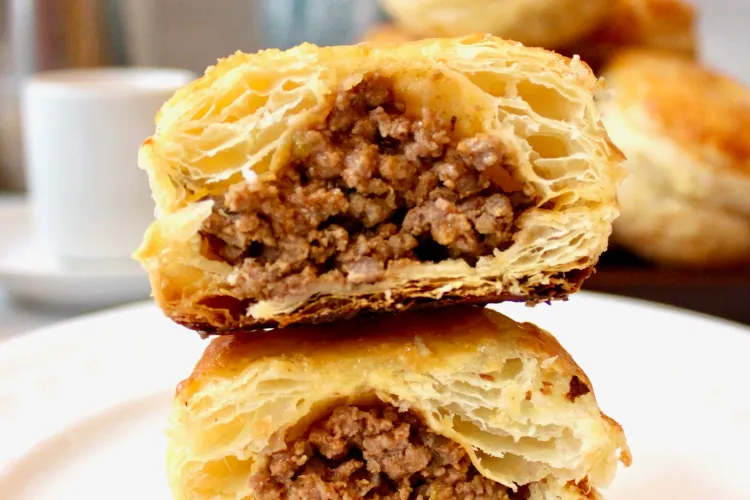Featured
- Get link
- X
- Other Apps
Difference Between Empanadas and Pastelitos: Explained
Empanadas and pastelitos are two beloved pastries found throughout Latin American and Caribbean cuisines. At first glance, they may appear similar—both are dough-based pastries with various fillings.
However, upon closer examination, distinct differences emerge in their dough composition, fillings, preparation methods, and cultural significance. This article delves into these aspects to provide a comprehensive understanding of what sets empanadas and pastelitos apart.


Defining Empanadas and Pastelitos
What is an Empanada?
An empanada is a turnover consisting of pastry and filling, baked or fried. The name comes from the Spanish verb “empanar,” meaning to wrap or coat in bread. Empanadas are popular in many Latin American countries, each offering its unique twist on the dish.
They can be filled with a variety of ingredients, including meats, cheeses, vegetables, and even fruits. The dough is typically made from wheat flour, resulting in a sturdy yet tender crust that encases the filling.


What is a Pastelito?
A pastelito, on the other hand, is a pastry that is often lighter and flakier than an empanada. The term “pastelito” translates to “little pastry” in Spanish.
Pastelitos are commonly found in Caribbean cuisines, particularly in Cuban and Dominican traditions. They are typically made with puff pastry dough, resulting in a delicate, airy texture. Fillings can be sweet or savory, with popular options including guava paste with cheese or seasoned meats.
Key Differences Between Empanadas and Pastelitos
Dough Composition
The primary distinction lies in the dough used for each pastry:

• Empanadas: Made with a thicker dough, often using wheat flour, which provides a more substantial bite. This dough can be baked or fried and is designed to hold up to hearty fillings.
• Pastelitos: Utilize a lighter, flakier pastry dough, commonly puff pastry, resulting in a delicate and crispy texture. This dough is typically baked to achieve its characteristic layers.
Fillings and Flavors
Both pastries offer a variety of fillings, but their traditional choices often differ:
• Empanadas: Commonly filled with savory ingredients such as seasoned beef, chicken, pork, or vegetables. Some regions also offer sweet versions with fruit fillings.
• Pastelitos: In Cuban cuisine, pastelitos are often sweet, filled with guava paste and sometimes combined with cream cheese. Savory versions may include spiced meats or cheeses.

Preparation Methods
The cooking techniques also set these pastries apart:
• Empanadas: Can be either baked or fried, depending on regional preferences and desired texture. Baked empanadas tend to have a firmer crust, while fried ones are crispier.
• Pastelitos: Typically baked to achieve the light, flaky layers characteristic of puff pastry. The baking process allows the dough to puff up and create its signature texture.
Regional Variations and Terminology

The names and interpretations of these pastries can vary significantly across different cultures:
• Empanadas: Widely recognized across Latin America, with each country adding its unique twist. For example, Argentine empanadas often feature beef with olives and hard-boiled eggs, while Colombian versions might include potatoes and rice.
• Pastelitos: In Puerto Rico and the Dominican Republic, the terms “pastelillo” and “empanadilla” are sometimes used interchangeably, though distinctions are made based on dough type and size. Pastelillos may refer to smaller, fried pastries with a thin dough, whereas empanadillas are larger with a thicker dough.

Cultural Significance
Both empanadas and pastelitos hold special places in their respective cultures:
- Empanadas: Often associated with festivals, family gatherings, and street food culture. They serve as a symbol of communal sharing and culinary tradition.
- Pastelitos: Particularly in In Puerto Rico, the terms “pastelillo” and “empanadilla” are often used interchangeably, leading to some confusion. However, subtle distinctions exist between the two.
Generally, “pastelillos” are made with a thinner, yellow-tinted dough, often seasoned with annatto (achiote) oil, giving them a distinctive color and flavor. They are typically smaller and sealed using a fork to crimp the edges.

On the other hand, “empanadillas” are usually larger, made with a thicker, white dough, and the edges are traditionally sealed by folding and twisting the dough, creating a In the Dominican Republic, the differentiation between “pastelitos” and “empanaditas” is often based on shape rather than dough or filling.

“Pastelitos” are typically round, while “empanaditas” are half-moon-shaped. Both varieties can be filled with similar ingredients, such as beef, chicken, or cheese, and are commonly served at celebrations and gatherings.

In Honduras, the term “pastelitos” refers to pastries similar to empanadas, often made with a corn-based dough and filled with seasoned meats or beans. These are typically fried and served with a cabbage slaw and tomato sauce. 
Conclusion
While empanadas and pastelitos share similarities as filled pastries cherished across Latin American and Caribbean cuisines, their distinctions are evident in dough composition, fillings, preparation methods, and regional interpretations.
Empanadas generally feature a sturdier, wheat-based dough suitable for baking or frying, accommodating a wide range of savory and sweet fillings. Pastelitos, conversely, often utilize a lighter, flakier puff pastry dough, predominantly baked, with fillings that vary from sweet guava and cheese to savory meats, depending on the region.
Understanding these nuances not only enriches our appreciation of these culinary delights but also offers insight into the diverse cultural tapestries from which they originate. Whether enjoying a hearty empanada or a delicate pastelito, each bite encapsulates a story of tradition, adaptation, and regional pride.
Disclosure: Our blog contains affiliate links to products. We may receive a commission for purchases made through these links. However, this does not impact our reviews and comparisons. We try our best to keep things fair and balanced, in order to help you make the best choice for you.
source https://sazonytumbao.com/empanadas-and-pastelitos/
- Get link
- X
- Other Apps
Popular Posts
Street Food Culture in the Caribbean: A Culinary Journey
- Get link
- X
- Other Apps
Comments
Post a Comment